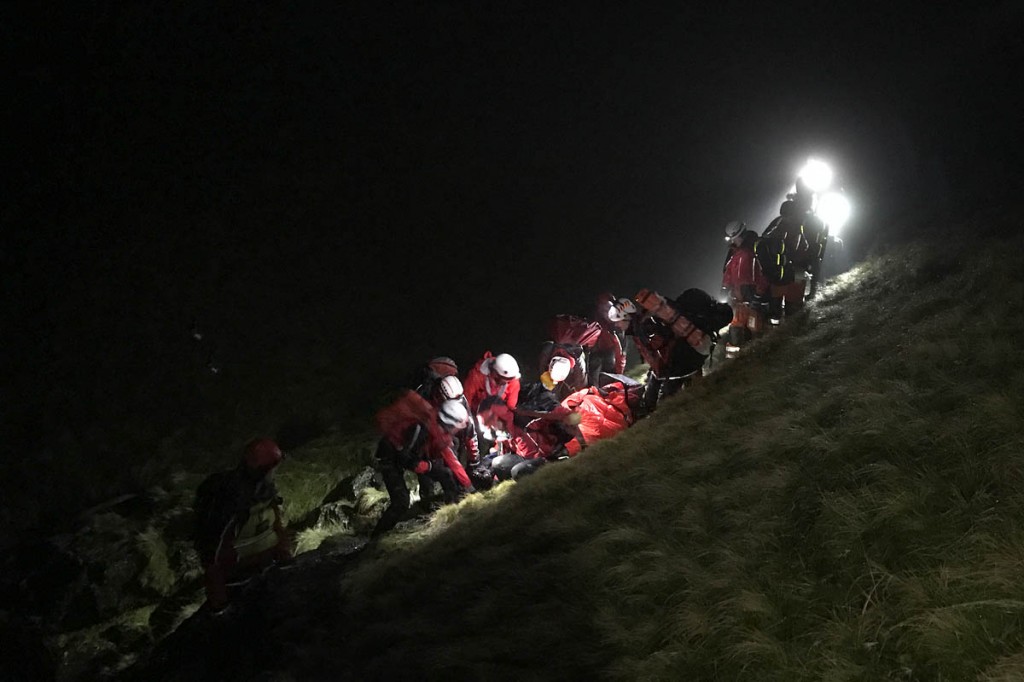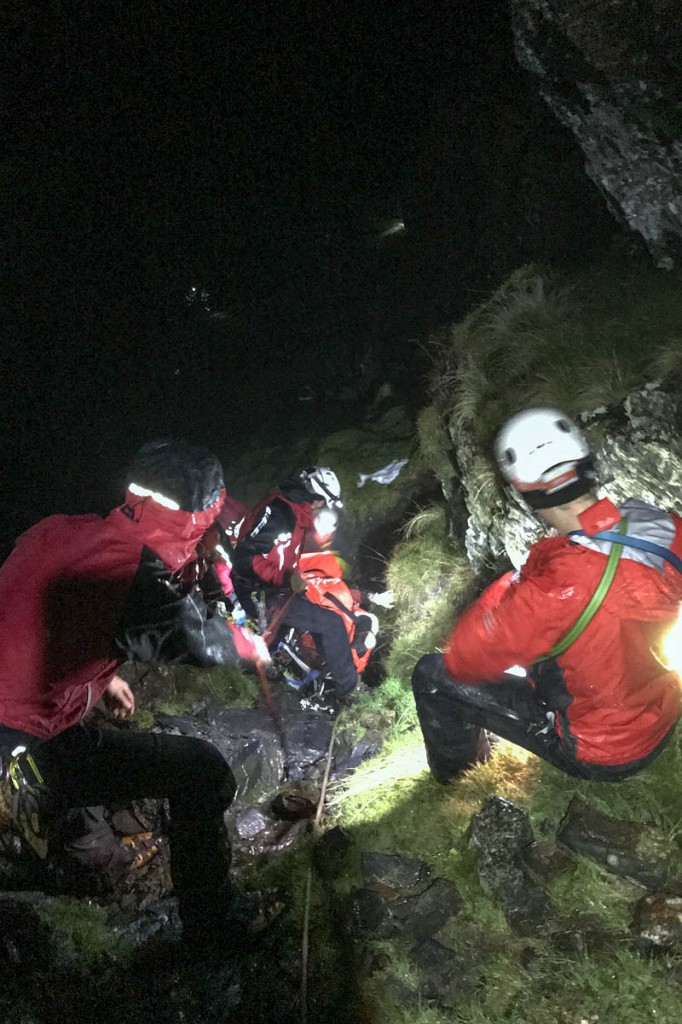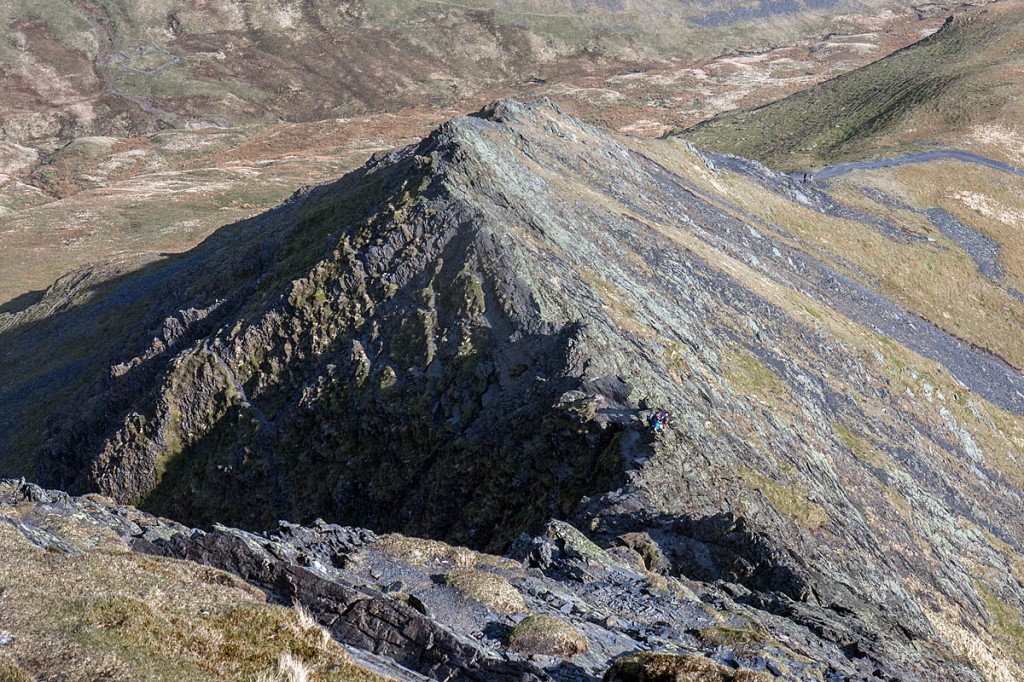A man was seriously injured after falling 160ft from a Lake District ridge.
More than 40 rescuers battled in bad weather to bring the 44-year-old man from Sharp Edge on Blencathra in an operation lasting more than six hours.
Keswick Mountain Rescue Team was alerted about 1.25pm on Sunday after the man fell 50m down the north side of the grade-one scramble route.
A Keswick MRT spokesperson said: “One of the places the team really doesn’t want to visit at this time of year is Sharp Edge, because of its wet slippery state after rain or snow.
“It is one of the team’s blackspots. So when the pagers summoned the team, it was with little surprise that we learned that a 44-year-old male had fallen 50m down the usual gully on the north side.
“His two companions had managed to reach him with the assistance of a passer-by, and found he was badly injured. The team was assembled and mobile within 20 minutes, after requesting the services of a Coastguard helicopter.
“The Great North Air Ambulance, Helimed 58 had also mobilised to the scene.”
The spokesperson said, as his team was initially low on numbers, it requested help from Penrith MRT and a visiting RAF team.
The spokesperson said: “The weather was a significant problem, with low cloud and drizzle. Despite this, the paramedic from the Great North Air Ambulance had managed to reach the casualty, who had head, neck and chest injuries.
“Team members rigged the route to ensure the safety of those in the gully, and the first task was to evacuate the casualty’s companions, and safeguard the medical personnel working on the casualty.
“The companions were walked down to safety by a pair of team members. The Coastguard helicopter then lifted relays of rescuers up the hill, and stood by at the bottom until the casualty had been loaded on to the stretcher, and lowered the further 50m down to the scree at the foot of the gully.
“This took a long time because of the conditions and the need to monitor the patient. During the wait, the weather deteriorated still further, and it became obvious that it would be impossible for the S-92 [helicopter] to evacuate the patient from the scene. The aircraft went to Carlisle for fuel, but once it returned, visibility was no better, and with regret, the aircraft was stood down.”
The spokesperson said the three teams were faced with stretchering the injured man down to the road, where the he could be put into the air ambulance. “Relays of rescuers, who by now were 47 strong, carried him down over treacherous terrain to eventually reach the foot of Mousthwaite Comb.
“Here he was loaded aboard Helimed 58, and flown to the Cumberland Infirmary. The rescue had taken 6½ hours, and at that point there was still all the clearing up to do.
“We are indebted to the teams and aircrew who came to assist us today, who helped us deliver our patient into safe care.
“We would again reiterate our advice that Sharp Edge is a dangerous place after snow or rain, and needs the greatest of care.”
The Great North Air Ambulance service said the man had multiple injuries including a serious head injury.
An air ambulance spokesperson said: “In strong wind and driving rain, the GNAAS pilot dropped off aircrew paramedic Terry Sharpe at the bottom of the gully before repositioning to a safer location on the valley floor.
“Mr Sharpe negotiated his way down the gully to reach the patient. For around an hour Mr Sharpe waited with the patient and his friends, assessing him and treating his injuries until the mountain rescue teams could get to the scene.”
Terry Sharpe said: “It is a notorious ridge and we have been called to it many times over the years.
“In those difficult weather conditions, the chances of survival decrease. Regardless of his head injury, hypothermia is a very real risk in those conditions. It is therefore paramount that teams work together at rescues like this.
“Everyone worked hard for the best outcome for the patient. GNAAS brings the medical expertise to the scene and MRT bring their rescue knowledge, which gels well.”
The GNAAS spokesperson said the stretcher carry to the helicopter took 1½ hours. Within 10 minutes of being put into the aircraft the injured walker had arrived at hospital in Carlisle. He was reported to be in a stable condition.
The rescue involved 23 Keswick MRT volunteers, 12 from the Penrith team and 14 RAF Mountain Rescue Service members.



Jean Casha
14 November 2016Thank God for the mountain rescue teams!
Dan Coulter
14 November 2016Yes indeed, thank God for the rescue teams but he shouldn't have gone there in the first place.
Sunday was not a good day for Sharp Edge. there are plenty of other routes up there for a wet autumn day.
Hope he's OK though
MunroMaiden
14 November 2016Sorry to quibble, but 50m isn't 'nearly 500 feet' - was it perhaps 150m?
Bob
14 November 2016Apologies. The fall was 50m, approximately 160ft. We've corrected the wrong figure.
Bob Smith
Editor
Bob
14 November 2016I went across there today and would like to help others to not underestimate this damp time of year. Here's a clip of it- https://www.youtube.com/watch?v=Qjj7YXAN6zE .You can see the mountain rescue's abandoned rope towards the end of the clip. I'm sure that they've reclaimed it by now but it just goes to show that they know when to leave the area. The conditions today were a lot worse than yesterday but are typical conditions for this time of year. I have recorded more than 1000 clips going across there so you can have a look at it in all sorts of conditions and at all times of the year. Damp conditions up there are the worst and the places where the accidents occur are where it doesn't dry out as quick as the rest of the ridge. Sometimes all of the ridge is dry accept for the couple of north facing places that drop down into the horrible gullies. Anyone could be unfortunate as to fall down there and those rocks will break your bones and possibly give you life changing or life threatening injuries. All I can advice is be very careful in damp conditions and turn back before it's too late if you don't feel comfortable. You can always go back there another day just like the mountain rescue will do for their rope!
Sarah Archer
14 November 2016I was on the ridge and saw the accident happen, I actually called emergency services for him....is there any news on his recovery? Can't stop thinking about him and really keen to hear how his recovery is coming on.
MRT have my utmost respect, absolutely incredible job they do.
Sarah Archer
15 November 2016I had just made the decision not to continue along the ridge when this man passed by, and as I was agonising over my decision... The accident happened.
I've climbed it easily 8 times this year but made the decision to turn back on sharp edge twice now, always in damp conditions. It's lethal when that polished rock is wet.
Rob Mackenzie
15 November 2016I've been up twice and both times in rainy conditions. The second time I put grips on my boots as I literally felt unsafe. Sharp Edge is very much underestimated as a climb. Very well done to each and every one of the MRT members....angels on our shoulders yet again. Check the weather conditions before you leave guys and as ever if you're unsure or feel unsafe...turn back!
C.S.
16 November 2016Secondhand info: he had surgery on two vertebrae and other injuries treated. He is stable now - no apparent brain injury or nerve damage.